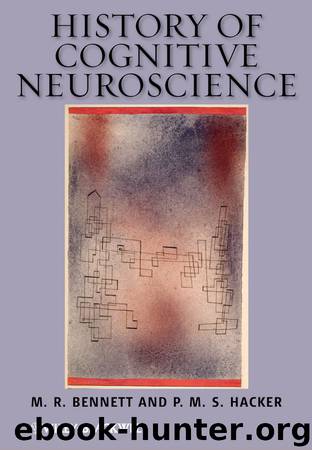History of Cognitive Neuroscience by Bennett M. R. Hacker P. M. S. & P. M. S. Hacker

Author:Bennett, M. R., Hacker, P. M. S. & P. M. S. Hacker
Language: eng
Format: epub
Publisher: Wiley
Published: 2012-08-12T16:00:00+00:00
4.6.2 Auditory compared with visual presentation of words
The above work of Petersen and colleagues involved determining those parts of the brain which are active when words are read. What parts are active when words are heard? Petersen and Fiez determined these in 1993, using PET scanning again. They showed that different regions of the brain were activated when real words are heard and understood: namely, the left temporo-parietal cortex (BA39) as well as the left anterior superior temporal region (BA22). This is shown in fig. 4.9a, which presents PET studies of sagittal slices like those in Plate 4.2 when words are read (left slices) and when words are heard (right slices), with the upper set of slices taken 25 mm left of the midline, and the lower slices 53 mm left of the midline. The upper left image shows extrastriate visual cortex activation posteriorly for words read (compare with Plate 4.2c and d) with no activation in the corresponding slice (upper right) for words heard. The opposite holds true for the more lateral slices (i.e. 53 mm left of the midline rather than 25 mm left of the midline). The principal area active for words heard is shown in the left temporo-parietal cortex (BA39).
Fig. 4.9. a: activated areas of the brain, ascertained with PET, during passive visual (left) and auditory (right) presentations of words. (The upper slices are taken 25 mm left of midline, and the lower slices are taken 53 mm left of midline.) b: activated areas of the brain when subjects repeat aloud visually presented words with a control condition of visual presentation (the left image is 40 mm left of midline and shows activation in primary motor cortex (MTR) and premotor cortex (PRMTR)); the right image is taken near the midline and shows activation in supplementary motor cortex (SMA) and midline cerebellum (CBLM). c: activated areas of the brain when subjects spoke verbs appropriate to visually presented nouns (upper left, 40 mm from midline, activation in left prefrontal (LFT, FRTL); upper right, near midline and shows activation in anterior cingulate (ANT, CING); lower image, 25 mm right of midline, shows activation in lateral cerebellum (RT.CBLM). (Petersen and Fiez, 1993, figs 1–3.)
Download
This site does not store any files on its server. We only index and link to content provided by other sites. Please contact the content providers to delete copyright contents if any and email us, we'll remove relevant links or contents immediately.
Periodization Training for Sports by Tudor Bompa(8210)
Why We Sleep: Unlocking the Power of Sleep and Dreams by Matthew Walker(6655)
Paper Towns by Green John(5138)
The Immortal Life of Henrietta Lacks by Rebecca Skloot(4550)
The Sports Rules Book by Human Kinetics(4342)
Dynamic Alignment Through Imagery by Eric Franklin(4176)
ACSM's Complete Guide to Fitness & Health by ACSM(4019)
Kaplan MCAT Organic Chemistry Review: Created for MCAT 2015 (Kaplan Test Prep) by Kaplan(3970)
Introduction to Kinesiology by Shirl J. Hoffman(3743)
Livewired by David Eagleman(3729)
The Death of the Heart by Elizabeth Bowen(3578)
The River of Consciousness by Oliver Sacks(3572)
Alchemy and Alchemists by C. J. S. Thompson(3481)
Bad Pharma by Ben Goldacre(3396)
Descartes' Error by Antonio Damasio(3248)
The Emperor of All Maladies: A Biography of Cancer by Siddhartha Mukherjee(3112)
The Gene: An Intimate History by Siddhartha Mukherjee(3074)
The Fate of Rome: Climate, Disease, and the End of an Empire (The Princeton History of the Ancient World) by Kyle Harper(3032)
Kaplan MCAT Behavioral Sciences Review: Created for MCAT 2015 (Kaplan Test Prep) by Kaplan(2957)
